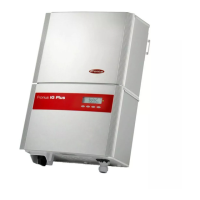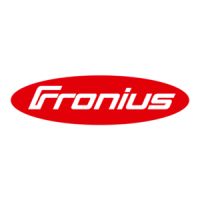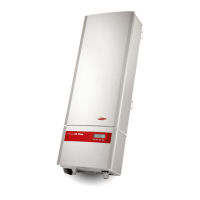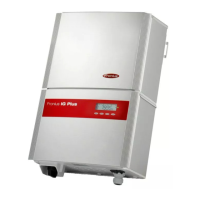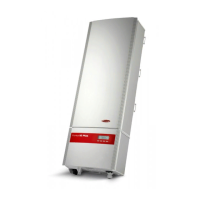Do you have a question about the Fronius IG 15 and is the answer not in the manual?
Welcome and overview of the manual's purpose and importance.
Defines DANGER, WARNING, CAUTION, and NOTE levels for hazards.
Information on safe operation, manufacturing, and operator qualifications.
Defines correct use and manufacturer liability for improper use.
Ambient conditions and requirements for qualified installation staff.
Machine location safety including airflow and noise considerations.
Explains emission classes and how to rectify interference issues.
Electrical installation standards, ESD protection, and safe operation.
Proper disposal instructions and user responsibility for data backup.
Warning about incorrect operation and the need for qualified staff.
Accessing unit components requires qualified personnel and de-energization.
ENS monitoring scheme and safety function during mains interruptions.
PV generator voltage checks and mains connection requirements.
Lists standards and regulations the FRONIUS IG unit complies with.
States that conformity declarations are found in the appendix.
Explains the basic principles of photovoltaic systems and energy generation.
Positions the unit as a link between modules and mains, performing key tasks.
Details automatic operation, MPPT, and shutdown procedures.
Explains HF-transformer for insulation and size reduction, ensuring high efficiency.
Monitors mains for protection and interrupts power during deviations.
Explains automatic operation, MPP-tracking, and dusk shutdown.
Details the self-test and mains network test during startup.
Continues detailing startup phase, including network synchronization and tests.
Illustrates and labels components of the indoor housing unit.
Illustrates and labels components of the outdoor housing unit.
Explains the meaning of different LED colors (green, flashing green, orange).
Explains LED colors (flashing orange, red, dark) and error code display.
Explains the functions of the display keys (A, B, C, D).
Explains various symbols used on the display and keys.
Details how to activate and manage the display lighting.
Explains how to enter the menu level from the display.
Describes how to select and enter different display modes.
Explains how to scroll between available display functions.
Lists the available display modes: Now, Day, Year, Total.
Provides a scheme of available display readings for different modes.
Explains how to select the "Now" display mode and its functions.
Details readings like module voltage, module power, and temperature.
Explains readings for isolation resistance and potential issues.
Explains the "Day" display mode and its parameters.
Explains "Year" and "Total" display modes and their data.
Details readings for mains voltage, module voltage, and energy consumption.
Covers temperature readings, ambient temperature, and insolation.
Provides a scheme of menu items for adjusting preset parameters.
Step-by-step guide to entering the setup menu.
Details how to scroll through menu items.
Explains how to set menu items like Standby.
Explains how to set Contrast and Light Mode.
Explains how to set Currency (Cash) and IG-NR (Inverter Number).
Explains the DatCom setup for data communication and signal card tests.
Details how to set the Date and Time.
Explains how to activate/deactivate Isolation Warning (Extended).
Details how to display the status of power stage sets (State_PS).
Explains how to view version numbers for control unit, power stage, and ENS.
Lists system upgrade options like data loggers and displays.
Discusses LocalNet for system upgrades and communication.
Explains the function and benefits of the temperature-controlled air circulator.
General points for connecting solar modules and to the mains network.
Mains monitoring requirements and connecting multiple inverters.
Recommendations for AC-side overcurrent protection (fuses, breakers).
Lists alternatives for connecting solar modules and to the AC mains.
Instructions for connecting via terminal block within the housing.
Details on terminal block connections for AC and DC cables.
Instructions for connecting solar modules via DC plugs.
Details on DC plug connection examples and important notes.
Connecting modules and mains using plugs for easier installation.
Instructions for preparing and installing the AC plug.
Details on AC plug assembly and connection to the FRONIUS IG unit.
Instructions for fixing the unit on the wall and opening the cover.
Details on connecting cables and installing DC connections for outdoor units.
Overview of factory pre-set configuration and initial startup.
Guidance for personal configuration and LocalNet settings.
Lists system upgrade options like data loggers and displays.
Discusses LocalNet for system upgrades and communication.
Data recorder function and COM card requirement for LocalNet.
Step-by-step instructions for inserting system upgrade slot-in boards.
Instructions for inserting slot-in boards for external mounting.
LocalNet identifies upgrades; units need individual numbers for differentiation.
Example of recording data using a datalogger card and sensor box.
Illustrates system setup with datalogger, COM card, and sensor box.
Unit has self-diagnostic system for identifying defects and errors.
Explains codes like DCLOW and POWER LOW related to voltage/power.
Actions for dark display or insufficient no-load voltage.
Special diagnostic for errors in units with multiple power stages.
Temporary codes from the public mains network.
Codes related to ENS option and mains network parameters.
Lists codes 201-208, their designations, descriptions, and repairs.
Codes that appear during operation but don't cause permanent interruption.
Lists codes 301-304 related to overload and temperature excursions.
Codes requiring intervention from a trained Fronius service technician.
Lists codes 401-409 related to communication and component faults.
Lists codes 410-443 related to settings, communication, and power supply issues.
Codes that don't impair operation, displayed until cancelled.
Lists codes 501-512 related to ventilators, isolation, EEPROM, and addresses.
Lists codes 514-517 related to power stage communication and connections.
Advice to contact dealer or technician for unlisted errors.
Provides technical specifications for FRONIUS IG 15/20/30 models.
Provides technical specifications for FRONIUS IG 40/60/60 HV models.
Lists EU directives, European standards, and country-specific regulations.
Information on warranty terms and registration for the inverter.
Instructions for maintenance and recycling of the equipment.
Declaration of conformity statement with product details and standards.
Certificate regarding the ENS function for photovoltaic inverters.
Company contact information and statement of compliance with regulations.
Provides contact information for Fronius International and Fronius USA.
Welcome and overview of the manual's purpose and importance.
Defines DANGER, WARNING, CAUTION, and NOTE levels for hazards.
Information on safe operation, manufacturing, and operator qualifications.
Defines correct use and manufacturer liability for improper use.
Ambient conditions and requirements for qualified installation staff.
Machine location safety including airflow and noise considerations.
Explains emission classes and how to rectify interference issues.
Electrical installation standards, ESD protection, and safe operation.
Proper disposal instructions and user responsibility for data backup.
Warning about incorrect operation and the need for qualified staff.
Accessing unit components requires qualified personnel and de-energization.
ENS monitoring scheme and safety function during mains interruptions.
PV generator voltage checks and mains connection requirements.
Lists standards and regulations the FRONIUS IG unit complies with.
States that conformity declarations are found in the appendix.
Explains the basic principles of photovoltaic systems and energy generation.
Positions the unit as a link between modules and mains, performing key tasks.
Details automatic operation, MPPT, and shutdown procedures.
Explains HF-transformer for insulation and size reduction, ensuring high efficiency.
Monitors mains for protection and interrupts power during deviations.
Explains automatic operation, MPP-tracking, and dusk shutdown.
Details the self-test and mains network test during startup.
Continues detailing startup phase, including network synchronization and tests.
Illustrates and labels components of the indoor housing unit.
Illustrates and labels components of the outdoor housing unit.
Explains the meaning of different LED colors (green, flashing green, orange).
Explains LED colors (flashing orange, red, dark) and error code display.
Explains the functions of the display keys (A, B, C, D).
Explains various symbols used on the display and keys.
Details how to activate and manage the display lighting.
Explains how to enter the menu level from the display.
Describes how to select and enter different display modes.
Explains how to scroll between available display functions.
Lists the available display modes: Now, Day, Year, Total.
Provides a scheme of available display readings for different modes.
Explains how to select the "Now" display mode and its functions.
Details readings like module voltage, module power, and temperature.
Explains readings for isolation resistance and potential issues.
Explains the "Day" display mode and its parameters.
Explains "Year" and "Total" display modes and their data.
Details readings for mains voltage, module voltage, and energy consumption.
Covers temperature readings, ambient temperature, and insolation.
Provides a scheme of menu items for adjusting preset parameters.
Step-by-step guide to entering the setup menu.
Details how to scroll through menu items.
Explains how to set menu items like Standby.
Explains how to set Contrast and Light Mode.
Explains how to set Currency (Cash) and IG-NR (Inverter Number).
Explains the DatCom setup for data communication and signal card tests.
Details how to set the Date and Time.
Explains how to activate/deactivate Isolation Warning (Extended).
Details how to display the status of power stage sets (State_PS).
Explains how to view version numbers for control unit, power stage, and ENS.
Lists system upgrade options like data loggers and displays.
Discusses LocalNet for system upgrades and communication.
Explains the function and benefits of the temperature-controlled air circulator.
General points for connecting solar modules and to the mains network.
Mains monitoring requirements and connecting multiple inverters.
Recommendations for AC-side overcurrent protection (fuses, breakers).
Lists alternatives for connecting solar modules and to the AC mains.
Instructions for connecting via terminal block within the housing.
Details on terminal block connections for AC and DC cables.
Instructions for connecting solar modules via DC plugs.
Details on DC plug connection examples and important notes.
Connecting modules and mains using plugs for easier installation.
Instructions for preparing and installing the AC plug.
Details on AC plug assembly and connection to the FRONIUS IG unit.
Instructions for fixing the unit on the wall and opening the cover.
Details on connecting cables and installing DC connections for outdoor units.
Overview of factory pre-set configuration and initial startup.
Guidance for personal configuration and LocalNet settings.
Lists system upgrade options like data loggers and displays.
Discusses LocalNet for system upgrades and communication.
Data recorder function and COM card requirement for LocalNet.
Step-by-step instructions for inserting system upgrade slot-in boards.
Instructions for inserting slot-in boards for external mounting.
LocalNet identifies upgrades; units need individual numbers for differentiation.
Example of recording data using a datalogger card and sensor box.
Illustrates system setup with datalogger, COM card, and sensor box.
Unit has self-diagnostic system for identifying defects and errors.
Explains codes like DCLOW and POWER LOW related to voltage/power.
Actions for dark display or insufficient no-load voltage.
Special diagnostic for errors in units with multiple power stages.
Temporary codes from the public mains network.
Codes related to ENS option and mains network parameters.
Lists codes 201-208, their designations, descriptions, and repairs.
Codes that appear during operation but don't cause permanent interruption.
Lists codes 301-304 related to overload and temperature excursions.
Codes requiring intervention from a trained Fronius service technician.
Lists codes 401-409 related to communication and component faults.
Lists codes 410-443 related to settings, communication, and power supply issues.
Codes that don't impair operation, displayed until cancelled.
Lists codes 501-512 related to ventilators, isolation, EEPROM, and addresses.
Lists codes 514-517 related to power stage communication and connections.
Advice to contact dealer or technician for unlisted errors.
Provides technical specifications for FRONIUS IG 15/20/30 models.
Provides technical specifications for FRONIUS IG 40/60/60 HV models.
Lists EU directives, European standards, and country-specific regulations.
Information on warranty terms and registration for the inverter.
Instructions for maintenance and recycling of the equipment.
Declaration of conformity statement with product details and standards.
Certificate regarding the ENS function for photovoltaic inverters.
Company contact information and statement of compliance with regulations.
Provides contact information for Fronius International and Fronius USA.
